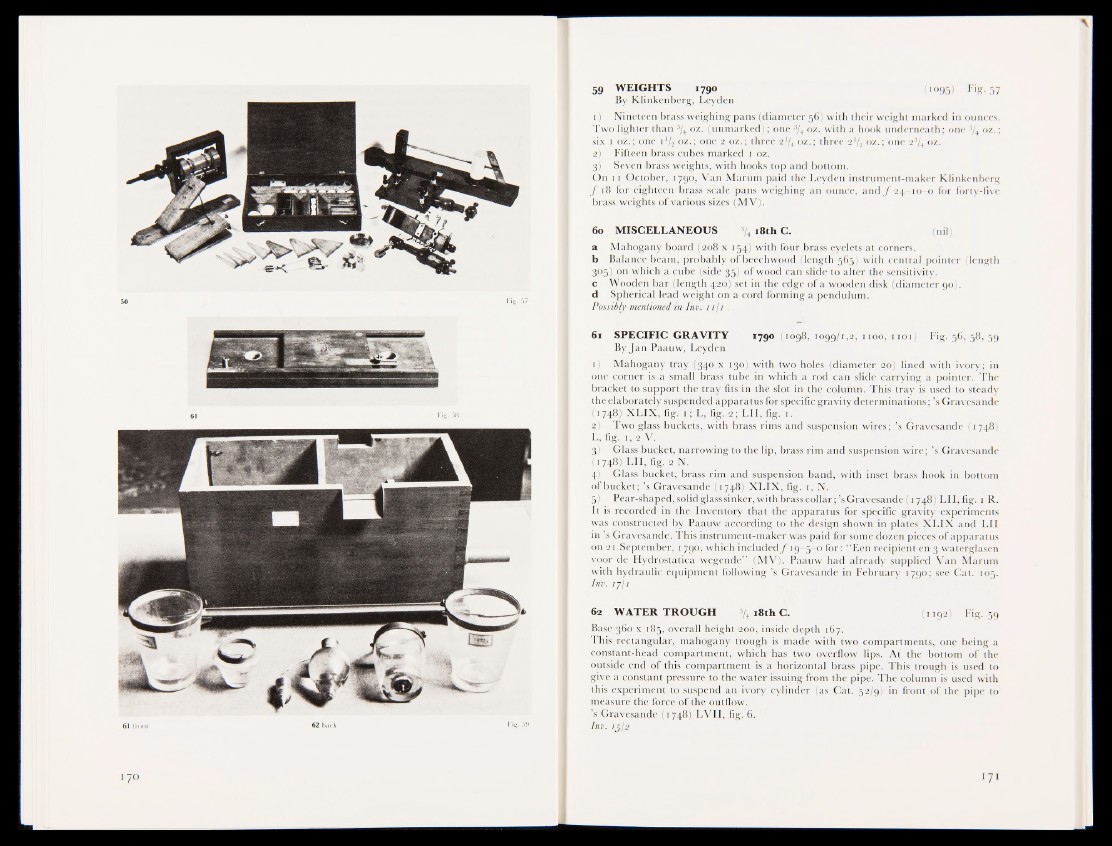
m*.
59 WEIGHTS 1790 (1095) Fig. 57
By Klinkenberg, Leyden
1) Nineteen brass weighing pans (diameter 56) with their weight marked in ounces.
Two lighter than 3/4 oz. (unmarked); one 3/4 oz. with a hook underneath; one 3/4 oz.;
six 1 oz.; one i'/2 oz.; one 2 oz.; three 274 oz.; three 2*/2 oz.; one 23/4 oz.
2) ; Fifteen brass cubes marked 1 oz.
37 Seven brass weights, with hooks top and bottom.
On 11 October, 1790, Van Marum paid the Leyden instrument-maker Klinkenberg
ƒ 18 for eighteen brass scale pans weighing an ounce, and ƒ 24-10-0 for forty-five
brass weights of various sizes (MV)*
60 MISCELLANEOUS 3/4 18th C. (nil)
a Mahogany board (208 x 154) with four brass eyelets at corners,
b Balance beam, probably of beechwood (length 565) with central pointer (length
305) on which a Cube (side 35) of wood can slide to alter the sensitivity,
c Wooden bar (length 420) set in the edge of a wooden disk (diameter 90).
d Spherical lead weight on a cord forming a pendulum.
Possibly mentioned in Inv. n \ i .
61 SPECIFIC GRAVITY 1790 (1098, 1099/1,2, 1100, 1101) Fig. 56, 58, 59
By Jan Paauw, Leyden
11 Mahogany tray,(340 x 130) with two holes (diameter 20) lined with ivory; in
one corner is a small brass tube in which a rod can slide carrying a pointer. The
bracket to support the tray fits in the slot in the column. This tray is used to steady
the elaborately suspended apparatus for specific gravity determinations; ’s Gravesande
(1748) XLIX, figip; L, fig. 2; LII, fig. 1.
2) Two glass buckets, with brass rims and suspension wires; ’s Gravesande (1748)
L, fig. 1, 2 V.
3) Glas jbucket, narrowing to the lip, brass rim and suspension wire; ’s Gravesande
(1748) LII, fig. 2 N.
4) Glass bucket, brass rim and suspension band, with inset brass hook in bottom
of bucket; ’s Gravesande (1748): XLIX, fig. 1, N.
ftlB Pear-shaped, solid glass sinker, with brass collar; ’s Gravesande (1748) LII, fig. 1 R.
It is recorded in the Inventory that the apparatus for specific gravity experiments
was constructed by Paauw according to the design shown in plates XLIX and LII
in ’s Gravesande. This instrument-maker was paid for some dozen pieces of apparatus
on 21 September, 1790, which included f ig—5—0 for: “ Een recipient en 3 waterglasen
voor de Hydrostatica wegende” (MV). Paauw had already supplied Van Marum
with hydraulic equipment following’s Gravesande in February 1790; see Cat. 105.
Inv. r^i
62 WATER TROUGH 3/4 i8tH C. (1192) Fig. 59
Base 360 x 185, overall height 200, inside depth 167.
This rectangular, mahogany trough is made with two compartments, one being a
constant-head compartment, which has two overflow lips. At the bottom of the
outside end of this compartment is a horizontal brass pipe. This trough is used to
give a constant pressure to the water issuing from the pipe. The column is used with
this experiment to suspend an ivory cylinder (as Cat. 52/9) in front of the pipe to
measure the force of the outflow.
’s Gravesande (1748) LVII, fig. 6.
Inv. ;j/i>